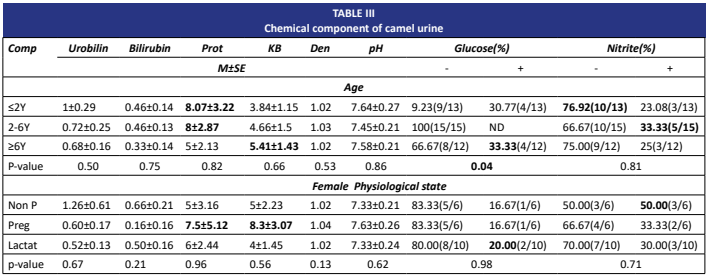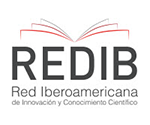Estudio transversal del perfil metabólico renal del camello de una joroba en la provincia de El-Bayadh (Algeria)
Resumen
La composición de la orina de camello puede variar en función de factores como la dieta del camello, su estado de salud y las condiciones ambientales. El objetivo de este estudio es investigar los diversos componentes de la orina de camello en la provincia de El-Bayadh, Argelia, mediante el examen macroscópico, microscópico y bioquímico de la orina, así como el análisis del plasma. Se analizó un total de 40 muestras de orina y 40 de plasma de camellos clínicamente sanos. La orina macroscópica mostró un color amarillo ámbar y turbidez en los dromedarios de 2 y 6 años de edad. Así, el examen microscópico registró la misma presencia moderada de células epiteliales y leucocitos en las hembras no gestantes y lactantes (P=0,001). Los camellos adultos presentan una presencia moderada de leucocitos en la orina en comparación con los camellos jóvenes, mientras que la raza Targui presenta un nivel moderado de leucocitos y eritrocitos (P=0,01). El pH (potencial de hidrógeno) de la orina de camello varía entre 7 y 8, la densidad se sitúa entre 1,02 y 1,04. Sin embargo, los niveles medios elevados de cetona (8,3±3,07) en las hembras gestantes (mayores de 6 años) y de glucosa es importantes en las hembras lactantes, y se hallaron niveles medios muy bajos de bilirrubina y urobilina (0,16 y 1,26). Por consiguiente, se registraron niveles medios elevados de proteínas en las hembras gestantes (7,5 ± 5,12), los camellos jóvenes (8 ± 2,87) y ausencia total de amoníaco. El análisis bioquímico del plasma mostró: un efecto significativo de la edad sobre la creatinina, con niveles más elevados en las camellas lactantes, 30,40 ± 0,71 mg/dL de proteína total y 51,24 ± 1,02 mg/dL de albúmina. Este estudio puso de manifiesto los diferentes componentes de la orina de camello y analizó la función renal. Se recomienda realizar nuevos estudios.
Descargas
Citas
Pastrana IC, Delgado Bermejo JV, Sgobba MN, Navas González FJ, Guerra L, Pinto DCGA, Gil AM, Duarte IF, Lentini G, Ciani E. Camel (Camelus spp.) Urine Bioactivity and Metabolome: A Systematic Review of Knowledge Gaps, Advances, and Directions for Future Research. Int. J. Mol. Sci. [Internet]. 2022; 23(23):15024. doi: https://doi.org/p2wb DOI: https://doi.org/10.3390/ijms232315024
Ali A, Baby B, Vijayan R. From desert to medicine: A review of camel genomics and therapeutic products. Front. Genet. [Internet]. 2019; 10:17.doi: https://doi.org/gstj6r DOI: https://doi.org/10.3389/fgene.2019.00017
Boukert R, Saidj D, Bekki MY, Sahraoui N. Prospective study on camel breeding in the province of Bechar. Rev. BioRessour. [Internet]. 2023 [cited 12 May 2025]; 13(2):100–111. Available in: https://goo.su/g4An
Senoussi A, Abazi A, Bezziou S, Brahimi Z. The Camel in Algeria: Animal of the Past, Present and Future: What Is the Scope of Farming Systems?. Biol. Life Sci. Forum. [Internet]. 2023; 22 (1):3. doi: https://doi.org/pxdp DOI: https://doi.org/10.3390/blsf2023022003
Abdel-Gader AGM, Alhaider AA. The unique medicinal properties of camel products: A review of the scientific evidence. J. Taibah Univ. Med. Sci. [Internet]. 2016; 11(2):98–103. doi: https://doi.org/p2wc DOI: https://doi.org/10.1016/j.jtumed.2015.12.007
Ressmi A, Aniba R, Raqraq H, Dihmane A, Barguigua A. Ethnopharmacological survey of the therapeutic use of camel urine in the Guelmim-Oued Noun and Laayoune- Sakia El Hamra regions of Morocco. [Internet]. Sci. Afr. 2024; 26:e02377. doi: https://doi.org/p2wd DOI: https://doi.org/10.1016/j.sciaf.2024.e02377
Savica V, Calò LA, Santoro D, Monardo P, Mallamace A, Bellinghieri G. Urine therapy through the centuries. J. Nephrol. [Internet]. 2011; 24(Suppl17):S123-S125. doi: https://doi.org/bhdmg4 DOI: https://doi.org/10.5301/JN.2011.6463
Salamt N, Idrus RBH, Kashim MIAM, Mokhtar MH. Anticancer, antiplatelet, gastroprotective and hepatoprotective effects of camel urine: A scoping review. Saudi Pharm. J. [Internet]. 2021; 29(7):740-750. doi: https://doi.org/gkfmdq DOI: https://doi.org/10.1016/j.jsps.2021.05.006
Ahamad SR, Alhaider A, Raish M, Shakeel F. Metabolomic and elemental analysis of camel and bovine urine by GC– MS and ICP–MS. Saudi J. Biol. Sci. [Internet]. 2017; 24(1): 23–29. https://doi.org/p2wf DOI: https://doi.org/10.1016/j.sjbs.2015.09.001
Pugh DG, Baird AN. Sheep and Goat Medicine. 2nd ed.Philadelphia: WB Saunders; 2012 [cited 12 May 2025]. Available in: https://goo.su/nSGLP
Perrot F, Herman N. «L’analyse d’urine : optimiser son interprétation en élevage.» Le Nouv. Prat. Vét. élev. & santé. [Internet]. 2022; 14:14–20. doi: https://doi.org/p2wg DOI: https://doi.org/10.1051/npvelsa/2023004
Alkhamees OA, Alsanad SM. A Review of the therapeutic characteristics of camel urine. Afr. J. Tradit. Complement. Altern. Med. 2017; 14(6):120–126. doi: https://doi.org/p2wh DOI: https://doi.org/10.21010/ajtcam.v14i6.12
Faye B, Bengoumi M. Camel clinical biochemistry and hematology. Cham, Suiza: Springer International Publishing AG. 2018. doi: https://doi.org/p2wj DOI: https://doi.org/10.1007/978-3-319-95562-9
Alsaad KM. The Common Blood Parasitic Infections of Dromedaries Camelus dromedaries: A Review. Basrah J. Agric. Sci. [Internet]. 2021; 34(1):222–229.doi: https://doi.org/p2wk DOI: https://doi.org/10.37077/25200860.2021.34.1.19
Ismail-Hamdi S, Gharbi M, Hamdi N, Yahia SB, Yahia HB, Chandoul W, Smida BB, Romdhane SB. Haematological profile of dromedary camels naturally infected with Trypanosoma evansi. Emir. J. Food Agric. [Internet]. 2022; 34(8):688–695.doi: https://doi.org/p2wn DOI: https://doi.org/10.9755/ejfa.2022.v34.i8.2903
Osman TEA, Al-Busadah KA. Effects of age and lactation on some biochemical constituents of camel blood in Saudi Arabia. J. Camel Pract. Res. [Internet]. 2000; 7(2): 149-152.
Direction des Système d’Information,des Statistiques et de la Prospective. Statistiques Agricoles. Serie B, 2018 [Internet]. Alger: Ministère de l’Agriculture et du Développement Rural; 2021 [cited 12 May 2025]. Available in: https://goo.su/d7LOH
Coles EH. Veterinary clinical pathology. 4th ed.Philadelphia: WB Saunders Company; 1986.
VIDAL. Les Tests urinaires par bandelettes. [Internet]. Madrid, Spain: VIDAL Vademecum. 2024. Available in: https://goo.su/8wW6m
Finco DR. Kidney function. In: Kaneko JJ, Harvey JW, Bruss ML, editors. Clinical Biochemistry of Domestic Animals. 5th ed. Singapore: Harcourt Brace and Company Asia PTE. Limited. 1997 [cited 12 May 2025]; p. 441-484. DOI: https://doi.org/10.1016/B978-012396305-5/50018-X
Reppas G, Foster SF. Practical urinalysis in the cat 1: Urine macroscopic examination tips and traps. J. Feline Med. Surg. [Internet]. 2016; 18(3):190–202.doi: https://doi.org/f8c9qs DOI: https://doi.org/10.1177/1098612X16631228
Fowler ME. Medicine and Surgery of South American Camelids: Llama, Alpaca, Vicuña, Guanaco 2nd ed. Ames, Iowa: Wiley-Blackwell; 1999. p.340.
El-Hady E, Behairy A, Goda NA, Abdelbaset-Ismail A, Ahmed AE, Al-Doaiss AA, Abd El-Rahim I, Alshehri MA, Aref M. Comparative physiological, morphological, histological, and AQP2 immunohistochemical analysis of the Arabian camels (Camelus dromedarius) and oxen kidney: Effects of adaptation to arid environments. Front. Anim. Sci. [Internet]. 2023; DOI: https://doi.org/10.3389/fanim.2023.1078159
Aitekenov S, Gaipov A, Bukasov R. Review: Detection and quantification of proteins in human urine. Talanta. [Internet]. 2021; 223(Part 1):121718. doi: https://doi.org/p225 DOI: https://doi.org/10.1016/j.talanta.2020.121718
Alhidary IA, Abdelrahman MM, Harron RM. Effects of a long-acting trace mineral rumen bolus supplement on growth performance, metabolic profiles, and trace mineral status of growing camels. Trop. Anim. Health Prod. [Internet]. 2016; 48(4):763-768. doi: https://doi.org/f8gfd2 DOI: https://doi.org/10.1007/s11250-016-1022-9
Mc Gavin MD, Zachary JD. Pathologic Basis of Veterinary Diseases. 4th ed. St. Louis: Mosby-Elsevier; 2007.
Tharwat M, Almundarij TI, Sadan M, Khorshid F, Swelum A. Is camel’s urine friend or enemy? Review of its role in human health or diseases. Open Vet. J. [Internet]. 2023, 13(10):1228-1238.doi: https://doi.org/p226 DOI: https://doi.org/10.5455/OVJ.2023.v13.i10.1
Alebie G, Yohannes S, Worku A. Therapeutic applicationsof camel’s milk and urine against cancer: Current development efforts and future perspectives. J. Cancer Sci. Ther. 2017; 9:5. doi: https://doi.org/p227 DOI: https://doi.org/10.4172/1948-5956.1000461
Amer H, Al-Hendi A. Physical, biochemical and microscopically analysis of camel urine. J. Camel Practice Res. [Internet]. 1996, 3:17–21
Mohamed RH, Khalphallah A, Nakada K, Elmeligy E, Hassan D, Ebissy EA, Ghandour RA, Mousa SA, Hassaneen ASA. Clinical and Correlated Responses among Steroid Hormones and Oxidant/Antioxidant Biomarkers in Pregnant, Non-Pregnant and Lactating CIDR-Pre-Synchronized Dromedaries (Camelus dromedarius). Vet. Sci. [Internet]. 2021; 8(11):247. https://doi.org/p228 DOI: https://doi.org/10.3390/vetsci8110247
Kamalu T, Okpe G, Williams A. Mineral contents of extracellular fluids in camel and cattle in the North East Sahel region of Nigeria. Niger. Vet. J. [Internet]. 2003; 24(1):13–20. https://doi.org/dtrdv7 DOI: https://doi.org/10.4314/nvj.v24i1.3431
Mostafa MS, Dwedar RA. Antimicrobial activity of camel’s urine and its effect on multidrug resistant clinical bacterial and fungal isolates. J. Pharm. Res. Int. [Internet]. 2016; 13(4):1–6. doi: https://doi.org/p229 DOI: https://doi.org/10.9734/BJPR/2016/29342
Martín-Barrasa JL, Tejedor-Junco MT, Cabrera S, Morales M, Melián A, Corbera JA. Haematological and biochemical blood reference values for Canary Island camels (Camelus dromedarius), an endangered dromedary species. Saudi J. Biol. Sci. [Internet]. 2023; 30(6):103677.doi: https://doi.org/p23b DOI: https://doi.org/10.1016/j.sjbs.2023.103677
Elitok B, Cirak AC. Clinical hematological and blood biochemical features of camels. MOJ Immunol. [Internet]. 2018 [cited 12 May 2025]; 6(5): 288-295. Available in: https://goo.su/xOyw
Lamo D, Gahlawat G, Kumar S, Bharti VK, Ranjan P, Kumar D, Chaurasia OP. Morphometric, haematological and physio-biochemical characterization of Bactrian (Camelus bactrianus) camel at high altitude. BMC Vet. Res. [Internet]. 2020; 16:291.doi: https://doi.org/p23c DOI: https://doi.org/10.1186/s12917-020-02481-6
Faraz A, Waheed A, Tauqir NA, Mirza RH, Ishaq HM, Nabeel MS. Effect of pregnancy on blood biochemical profile of semi-intensive kept Marecha (Camelus dromedarius) camel. Int. J. Agric. Biol. [Internet]. 2021 [cited 12 May 2025]; 25(1):241-248. Available in: https://goo.su/EH6gP9
Wako RJ, Kebede YK, Amejo AG. Effects of season, productive state, age, and agro-ecology on blood biochemical characteristics and nutritional condition of dromedary camels (Camelus dromedarius) in natural browsing environment. Asian J. Dairy Food Res. [Internet]. 2024; 43(2):368-372. doi: https://doi.org/p23d DOI: https://doi.org/10.21203/rs.3.rs-2400587/v1
Abdalmula AM, Buker AO, Benashour FM, Shmela ME, Abograra IM, Alnagar FA. Blood profile in normal one humped dromedary (Camelus dromedarius) camel breeds in Libya. Part 4: Effect of Age Variation onbiochemical and hematological blood profile. Alq. J. Med. App. Sci. [Internet]. 2023; 6(1):219-224. doi: https://doi.org/p23f
AL-Zubaidy IAH, Waheed LS, Al-Jabory HAH, Abass MA, Salh AH. Investigation on serum traceelements status (Copper, Iron and Zink) in Iraqi camels (Camelus dromedarius).Plant Arch. [Internet]. 2020 [cited 12 May 2025]; 20(1):1812-1816. Available in: https://goo.su/czwId
Nazifi S, Gheisari HR, Poorabbas H. The influences of thermal stress on serum bio-chemical parameters of dromedary camels and their correlation with thyroid activity. Comp. Haematol. Int. [Internet]. 1999; 9:49-54. doi: https://doi.org/dt5ccm DOI: https://doi.org/10.1007/PL00010007
Deen A. Serum creatinine, urea nitrogen and endogenous creatinine clearance based glomerular filtration rate in camels to evaluate renal functions. Camel Int. J. Vet. Sci. [Internet]. 2013 [cited 12 May 2025]; 1(1):1-12. Available in: https://goo.su/z3l0fYy
Omidi A, Fathi MH, Asiaban M. Elevated levels of blood urea nitrogen and creatinine in the last trimester of pregnancy of dromedary camels (Camelus dromedarius). Iranian J. Vet. Med. [Internet]. 2016; 9(4):249.255. doi: https://doi.org/p23j
Rasheda A, Sun-Young A, Asha M, Chapter 7 - Kidney andurinary tract disorders. In: Dietzen D, Bennett M, Wong E, Haymond S, editors. Biochemical and Molecular Basis of Pediatric Disease. 5th ed. Elsevier BV: Academic Press; 2021. p.167-228. doi: https://doi.org/p23m DOI: https://doi.org/10.1016/B978-0-12-817962-8.00010-X
Saeed A, Hussain M, Khan I, Chand G, El-Yousuf R. Effect of sex and age on blood biochemical profile in camel. J. Camel Pract. Res. [Internet]. 2004 [cited 15 May 2025]; 11(1):73-76. Available in: https://goo.su/z28Pti
Ghodsian I, Nowrouzian I, Schels HF. A study of some haematological parameters in the Iranian camel. Trop. Anim. Health Prod. [Internet]. 1978; 10(2):109-110. doi: https://doi.org/bj4d25 DOI: https://doi.org/10.1007/BF02235320
Ben Romdhane S, Romdane MN, Feki M, Sanhagi H, Kaabachi N, M’Bazaa A. Blood biochemistry parameters in dromedary (Camelus dromedarius). Rev. Méd. Vét. [Internet]. 2003 [cited 15 May 2025]; 154(11):695–702. Available in: https://goo.su/5YHgrRn
Faye B, Mulato C. Facteurs de variation des paramètres protéo-énergétiques, enzymatiques et minéraux dans le plasma chez le dromadaire de Djibouti. Rev. Elev. Med. Vet. Pays Trop. [Internet]. 1991; 44(3):325-334. doi : https://doi.org/p24b DOI: https://doi.org/10.19182/remvt.9174
Ateeq G, Kouider S, Kolb E. Studies on the blood levels in the camel with regard to erythrocytes, hemoglobin, leukocytes, various forms of leukocytes, serum levels of proteins urea, cholesterol, aspartate and alanine aminotransferases as a function of age and sex. Arch. Exp. Veterinarmed. [Internet]. 1984 [cited 15 May 2025]; 38(5):664-675. PMID: 6529326. Available in: https://goo.su/cW6Yj
Souilem O, Chine O, Alguemi C, Gogny M. Etude de la glycémie chez le dromadaire (Camelus dromedarius) en Tunisie: résultats préliminaires. Rev. Méd. Vét.. [Internet]. 1999 [cited 15 May 2025]; 150(6):537-542. Available in: https://goo.su/fXNxhlx
Momenah MA. Some blood parameters of one humped she-camels (Camelus dromedarius) in response to parasitic infection. Life Sci. J. [Internet]. 2014. 11(5): 118-123.
Durrani AZ, Bashir Z, Rasheed I, Sarwar NU. Epidemiological study of common diseases and their risk factors in camels in South Punjab, Pakistan. Microb. Pathogen. [Internet]. 2017; 108:6-12. doi: https://doi.org/gbpkr8 DOI: https://doi.org/10.1016/j.micpath.2017.04.011
Ebissy EA, El-Sayed AA, Mohamed RH. Haematological and biochemical profile in female camels (Camelus dromedarius) during the transition period. Slov. Vet. Res. [Internet]. 2019; 56(22):571-577. doi: https://doi.org/p26j DOI: https://doi.org/10.26873/SVR-794-2019
Brar RS, Sandhu HS, Singh A. Veterinary Clinical Diagnosis by Laboratory Methods. New Delhi: Kalyani Publishers; 2000.
Jainudeen M, Hafez E. Gestation, prenatal physiology and parturition. In: Hafez E, editor. Artificial Domestic Animal reproduction and Insemination. 5th ed. México: Interamericana, McGraw-Hill;1989. p. 203-224.
Chacha F, Bouzebeda Z, Bouzebda -Afri F, Gherissi DE, Lamraoui R, Mouffok C. Body condition score and biochemical indices change in Montbeliard dairy cattle: influence of parity and lactation stage. Glob. Vet. [Internet]. 2018 [cited 15 May 2025]; 20(1):36-47. Available in: https://goo.su/DXO7nLy
Kelanemer R, Antoine-Moussiaux N, Moula N, Abu- median A, Hanzen C, Kaidi, R. Effect of nutrition on reproductive performance during the peripartum period of female camel (Camelus dromedarius) in Algeria. J. Anim. Vet. Adv. [Internet]. 2015 [cited 15 May 2025]; 14(7):192-196. Available in: https://goo.su/YI2J
El Zahar H, Zaher H, Alkablawy A, Al Sharifi S, Swelum A. Monitoring the changes in certain haematological and biochemical parameters in camels (Camelus dromedarius) during postpartum period. J. Fert. Biomark. [Internet]. 2017; 1(1):47-54. doi: https://doi.org/p26k DOI: https://doi.org/10.14302/issn.2576-2818.jfb-17-1595
Mirzaei-Aghsaghali AM, Fathi H. Lactose in ruminants feeding: A review.Ann. Biol. Res. [Internet]. 2012 [cited 15 May 2025; 3(1):645-650. Available in: https://goo.su/Fn0TSr
Ayoub MA, El-Khouly AA, Mohamed TM. Some hematological and biochemical parameters and steroid hormone levels in the one-humped camel during different physiological conditions. Emir. J. Agric. Sci. [Internet]. 2003; 15(1):44-55. doi: https://doi.org/p26p DOI: https://doi.org/10.9755/ejfa.v15i1.5281
Aichouni A, Dellal A, Jebmawi R. Influence de la saison sur les paramètres hématologiques du dromadaire (Camelus dromaderius) Algérien. Revue Méd. Vét. [Internet]. 2011 [cited 15 May 2025]; 162 (7):327-332. Available in: https://goo.su/rwU1H2E
Ghavipanje N, Vargas-Bello-Pérez E, Afshin M, Hosseini SA, Aghashahi A, Vatankhah AM. The Inclusion of Alhagi maurorum in Growing Camel Diet: Effect on Performance, Liver-Related Blood Metabolites, and Antioxidant Status. Front. Vet. Sci. [Internet]. 2022; 9:863121.doi: https://doi.org/g5xntv DOI: https://doi.org/10.3389/fvets.2022.863121
Babeker EA, Elmansoury YHA, Suleem AE. The Influence of Seasons on Blood Constituents of Dromedary Camel (Camelus Dromedarius). Online J. Anim. Feed Res. [Internet]. 2013 [cited 15 May 2025]; 3(1):01-08. Available in: Available in: https://goo.su/ASqJTC0
















